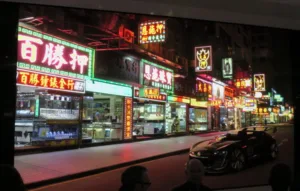The centerpiece of the Sony booth at ISE was its Cledis (Crystal LED Integrated Structure) big-screen display system, which was shown at ISE for the first time. It has been shown at multiple venues since it was introduced at InfoComm 2016, but I hadn’t seen it before. As Bob Raikes said, “it never fails to impress.” Well, I was impressed too.
The Cledis unit at ISE had 8K x 2K resolution and combines a high-contrast image (more than 1,000,000:1) with an impressive 1000 cd/m² brightness. Cledis is also capable of showing content with a frame rate of 120fps, has a wide color gamut (140% of sRGB) and 10-bit color depth. Volkswagen was at ISE with Sony and showing a concept car. From a distance, it was sometimes hard to tell which was the car and which was the image of the car, a useful property in an automotive design studio.
The Cledis display is built up of multiple ZRD-1 LED modules. Each module is 403mm × 453 mm with a 320 × 360 × RGB array of LED pixels, giving it a pixel pitch of 1.26mm. While other direct view LED displays have a pitch as fine as this, they don’t often seem as impressive as Cledis. One unique thing about the ZRD-1 module is it is mostly black, not LED surface. Sony says the LEDs cover about 1% of the module area, the other 99% is black to reduce light reflection and enhance contrast even under high ambient light conditions.
Sony’s Cledis image at ISE
Sony introduced two new 3LCD laser-phosphor (called Z-Phosphor by Sony) P-Series projectors at ISE, the WUXGA (1920 x 1200) VPL-PHZ10 and the WXGA (1280 x 800) VPL-PWZ10. Both of these projectors produce 5,000lm, both ANSI and color light output (CLO) and use 3 x 0.76” LCD microdisplays. The projectors have 20,000 hours of light source life (PHZ10 at light output mode “Middle”). Both are targeted at a wide range of education, business and entertainment environments. The new VPL-PHZ10 projector will be available from May 2017 and the VPL-PWZ10 from July 2017 across Europe.
 Sony P-Series projector at ISE
Sony P-Series projector at ISE
Sony also introduced seven new projectors in its E-Series, the VPL-EW578, VPL-EW575, VPL-EW455, VPL-EW435, VPL-EX575, VPL-EX455, and VPL-EX435. These projectors are all based on a 225W ultra-high pressure mercury life, with a lifetime of 4000 – 10,000 hours, depending on the power and lumen output mode chosen by the end user. Output of these projectors ranges from 4300lm to 3100lm, depending on the projector. Like the P-Series, these projectors are also aimed at both the corporate and education markets. The VPL-EX575, VPL-EX455 and VPL-EX435 will be available from April, while the VPL-EW578, VPL-EW575, VPL-EW455 and VPL-EW435 will be available from May.
 Sony E-Series projectors at ISE
Sony E-Series projectors at ISE
Sony was also showing the VPL-VZ1000ES 4K HDR home theatre projector which it had introduced in January at CES. This is a 3 panel SXRD projector, with 0.74” panels and true 4K (4096 x 2160 x 3) resolution. The output of 2500 lumens comes from a Sony Z-Phosphor laser-phosphor light source. At 24 dB, the projector is extremely quiet, important since the viewer will be seated near the projector in a typical application. The ultra-short throw lens allows the projector to make an image size up to 120” with the projector quite close to the wall. The unit has both zoom (1.02:1) and lens shift, unusual features in an ultra-short throw lens and simplifying alignment of the projector to the screen. Nice. –Matthew Brennesholtz
Sony, as it had at BETT, was focusing strongly on complete solutions although this time the target market was the corporate and enterprise segment, rather than education. First the firm showed us what it is doing in wayfinding and pointed out that there is not a great deal of work going on with dedicated solutions for this application, most being based on more generic digital signage software. Sony’s software integrates with its meeting room control and booking software. Sony has software that allows the analysis of the use of meeting rooms and statistics such as the time that rooms are used. Further, the software can be used to control aspects such as power, with remote control. The software has not yet been fully released yet, but is due to ship in April or May. At the moment, the software only works with Sony displays, but in the future, other brands will be supported.
Sony has a full set of meeting software, similar to that shown at BETT with messsaging, support for Outlook, and is built around a full content management system (CMS) with full support for templates based on HTML5 as well as support of touch displays. At the show, Sony had its 85″ and 100″ displays and was showing its mirroring dongle system. The dongle will work with any Bravia TV or signage display and uses Wi-Fi Direct, but the company is developing a USB key solution that would work with any display with a USB connection, we were told. Theoretically, up to ten client devices can be supported, but a realistic practical maximum is four.
Sony was privately showing a new OLED monitor for broadcasting and other specialist applications, but no details of dates or pricing were available at the show.
Analyst Comment
I heard, second hand and unconfirmed, at the end of the show that Sony is saying that it has sold around fifty of its Cledis displays so far. Given that the price of the display shown in Amsterdam was estimated at somewhere between $2.5 million and $3.5 million, that would be a good start! (BR)

